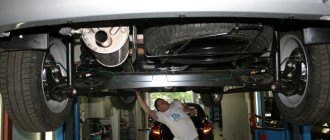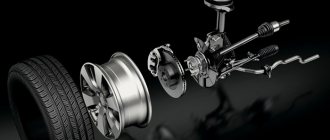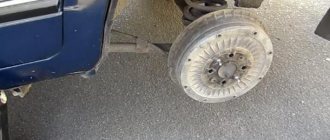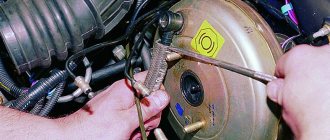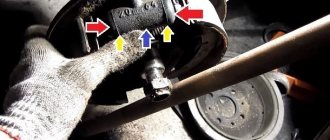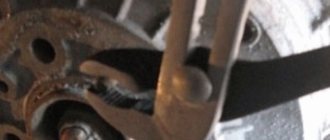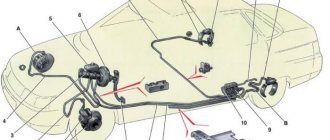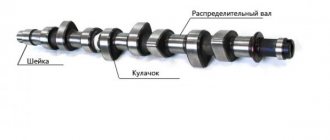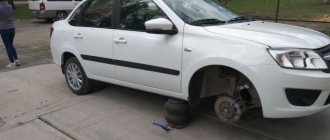Despite the fact that most cars today are equipped with a disc brake system, brake drum-type systems do not lose their relevance. They have been used in cars for more than a century and there has never been any doubt about their reliability. But like any brake system, they are subject to wear and tear during constant operation. Which, of course, immediately affects traffic safety. A worn part must be replaced, and in this article we will tell you how to remove the brake drum. We will present several different methods, but first we need to talk about the design of this element, its advantages and disadvantages, as well as possible malfunctions and options for eliminating them.
Element device
The rear brake drum consists of several parts :
- rotating drum;
- brake shoe;
- spring;
- brake cylinder (one or more).
Removing the drum
When braking, the brake pad rubs against the surface of the hollow drum. To ensure the mobility of the pad, the mechanism contains springs, which, depending on the position of the gas pedal, will be compressed or decompressed. A special cylinder is responsible for the correct operation of the pad and its timely operation, pressing it to the surface of the rotating drum under the pressure of the brake fluid. The entire mechanism is mounted on a shield made by stamping.
But the rear brake drum in some cases has a different device. One of the key elements of the tape structure, as the name implies, is flexible tapes made of metal. During the braking process, the belts are stretched and squeeze the drum tightly. However, this design of the braking system has not been used in cars for a long time.
The most severe case
A critical situation arises if not only the drum is stuck, but also the brake cylinder is completely jammed with it. Neither gas and a brake nor a sledgehammer will help here. You will have to take a drill and drill holes (small, 2-3 mm) at the junction of the drum and the axle shaft. Brake fluid pours into them - and again it’s the sledgehammer’s turn.
Those who like to tinker with their iron horse, who know how to remove a stuck brake drum and how problematic it can be, may have homemade pullers in their stash. Craftsmen sculpt them from springs according to the principle of a device used to dismantle axle shafts. If you have such a friend, borrow this device, it greatly simplifies the process.
About the advantages and disadvantages
Pros of drum brake
One of the main advantages of this mechanism is its reliable protection from external factors . This type of braking system is ideal for vehicles operating in difficult/extreme environmental conditions. Almost no dust penetrates into the brake pads; they are constantly in conditions of optimal humidity. And this significantly increases the working life of the entire mechanism. In addition, when braking in this design, a smaller amount of thermal energy is released, which allows the use of inexpensive fluids with a low boiling point.
Removing the brake drum
Another advantage of the drum brake system design is the increased braking power due to the diameter or width of the drum. This becomes possible due to the increased contact patch, the contact patch between the drum surface and the block. This is what significantly improves braking performance. At the same time, the rear brake drum, thanks to its design features, is able to increase operating efficiency. When braking, the rotating drum tends to “carry away” the brake pad, turning it.
Disadvantages of a drum brake system
But, despite the obvious advantages , this type of braking system has certain disadvantages:
- lower startup speed compared to disk analogues;
- some difficulties in setting up;
- low stability;
- When the rear brake drum heats up, the pads “stick” and a significant deterioration in braking performance occurs.
In addition, experts do not recommend using the handbrake at subzero temperatures. Cases of pads freezing to the drums often occur. To avoid such situations on modern and expensive cars, this type of braking system is replaced with a disc version. Basically, a brake system with rear drums is found on budget cars and small cars, in which they are placed on the rear wheels. Trucks are also equipped with this braking system.
Removing the brake drum
Removing the brake drum - why master this operation?
As you know, this brake mechanism consists of a stationary part (pads or band) and a movable part (the drum itself), and the braking process occurs through mechanical friction of these parts, thus the speed of rotation of the wheels slows down until it comes to a complete stop. The drum brake has a number of advantages, including low pricing, simplicity and the effect of mechanical self-reinforcement. After all, the lower parts of the pads are rigidly connected to each other, and when friction occurs between the drum and the front pad, additional force is created, which also presses the rear pad against it, which greatly increases the braking effect.
Removing a brake drum is a fairly common procedure, because its condition does not have the most favorable effect on the quality of our road surface. Also, increased air humidity has a negative impact, which contributes to the occurrence of corrosion, an aggressive driving style and sharp braking leads to overheating, not to mention an accident, after which it is quite possible that not only the brake system, but the entire car will need to be changed. So all of the above factors lead to rust, scratches, grooves, and other mechanical damage that can be easily identified by visual inspection.
In addition, the need to remove the drum also arises when it is necessary to assess the condition of the brake pad linings or when the brake cylinder breaks down.
Malfunctions: causes and symptoms
Since the participation of the rear wheels in braking is much less than that of the front wheels, the motorist does not immediately notice a decrease in the efficiency of their work. In this case, the process of reducing efficiency can last quite a long time.
Failures in the operation of drum brakes are felt when braking sharply - the car stops much more slowly. On many cars, failure of the drum braking system is especially noticeable when driving in reverse. The front brake system, which has become the rear, does not “want” to work effectively, stopping the car.
A leak of working fluid often leads to the shutdown of one or two circuits of the braking system - this provokes a decrease in its efficiency by up to 60%. Air in the hydraulics creates a soft pedal feel. In this case, the brake can only be applied at the end of the stroke.
If the pads are “skewed” or the spring/strut in the drum breaks, the motorist may hear grinding sounds . This leads to jamming and overheating of the drum. In addition, this leads to a decrease in vehicle acceleration and increased fuel consumption. Among the failures, “ovality” of the drum is often encountered.
Types of breakdowns
Among the most common reasons that involve removing the rear brake drum and replacing it due to loss of efficiency is not only wear on the pads, but also high wear on the drum itself. On its inner working surface the circumference increases. If the pads and working surface wear out immediately, there is a risk of pistons being squeezed out of the cylinder, wheels jamming, or brake fluid leaking.
Brake drum failure
On cars with high mileage, due to corrosion, the spring “sticks”, weakens or breaks . The pressure force may decrease significantly due to the fact that the handbrake cable has become loose. Not often, but it still happens that the friction linings peel off from the pads, then it is necessary to replace the brake pads on the rear drums.
"Renault Logan"
If with VAZ cars brute force was used to dismantle the brake elements, then in the case of Logan they use a different method. The first thing you do is engage first gear at the gearbox. Then the wheel chocks are placed under the two front wheels. Next, the decorative caps are dismantled, if they are on the wheels. When the caps are removed, carefully knock the protective cap out of the hub and remove it.
Then loosen the wheel bolts and the hub nut. In this case, the car must be on the ground. Next, lift the rear of the car and remove the wheel. Now you can unscrew the hub nut completely - when installing a new drum, you should also purchase a new nut.
The rear brake drum (Logan Dacia is no exception) is removed from the coupling journal, and along with it the bearing. In these cars, the mechanism is a single unit with the hub.
The second part is removed in the same way. If an old drum is to be installed, it is necessary to grind off the collar on its working surface. It is also necessary to bring the slack adjuster mechanism into working position and bring the brake pads together using mounting blades.
When installing, the Renault Logan rear brake drums must be tightened with a hub nut with a force of 175 Nm. After installation, it is necessary to adjust the gaps; to do this, depress the brake pedal several times. During the process, clicks will be heard - when the gap is adjusted, they will stop.
This allows the drum brake mechanism to be removed for maintenance or replacement. As you can see, you can perform this process yourself, saving money on service stations.
Troubleshooting methods
Before we talk about ways to remove the rear brake drum if it is stuck, you need to name the reasons why this can happen:
- Heating the brake pad causes the metal that makes up the drum to expand, causing the cover to stick to the body.
- Dirt accumulated between the cover and body.
- Rapid heating of the element during braking, and then sudden cooling (for example, in a puddle of water).
All this leads to sticking of the brake drum. Note that dismantling it is quite difficult. Therefore, experts do not recommend resorting to sharp braking in rainy weather, which is quite difficult to dismantle when replacing the pads. Now let’s talk about the most acceptable ways to remove a stuck drum.
If car service technicians cope with this task almost effortlessly, having sufficient experience and the necessary tools, then an ordinary motorist who decides to do such work on his own needs to stock up on a certain tool. Moreover, for each specific case this tool may be different.
But you will always need WD40, which is used when repairing various vehicles.
Brake drum lubrication
Sledgehammer to help you
Using this method requires reliable fixation of the car. It is better to perform all actions on a lift (a car jack is not able to provide maximum stability to a raised car). In addition, a metal goat designed to support the machine, or an ordinary stump from a large tree, may be suitable for this. Let's move on directly to the sequence of actions when dismantling the brake drum. You will need:
- Remove the wheel.
- Using a wire brush, clean the cavity from any accumulated dirt.
- Spray the surface generously with WD40.
- Gently tap the drum collar at the bottom until it becomes movable. There is no need to strike too hard - this can lead to damage to car parts.
But it is advisable to warn that this method has one significant drawback - not everyone has a sledgehammer and not everyone knows how to handle it. Therefore, it is advisable to consider other options for solving this problem.
Brake drum removed
Extreme way
This method involves absolute fixation of the machine . Before starting work, you should check everything carefully, because if the car comes off, the risk of serious injury increases by almost 100%. Having chosen this option for removing a stuck drum, you will need to perform the following steps:
- Get behind the wheel.
- Turn on the ignition.
- Engage 2nd (3rd) gear and release the clutch.
- Rotate the engine to medium speed.
- Shut down the power unit and remove the drum.
The meaning of this method is to spin the moving part of the axis, and therefore the drum itself, using centrifugal force. In this embodiment, the drum will simply be descaled.
Removing the brake drum
Radical measure
If suddenly the methods described above did not lead to the required result , in addition, the brake system cylinder is jammed, then it is advisable to take radical measures. To complete the work you will need a drill with a drill (diameter size 2-3mm), a medical syringe, and a sledgehammer. Here's what to do if all else fails:
- Make several holes at the junction of the axle shaft and the drum.
- Use a syringe to pour brake fluid into the holes and at the same time gently hit the drum with a sledgehammer.
To simplify operations, use a special removable key (you can buy it or make it yourself). After performing these steps, the stuck drum should come off. But, if you still can’t do this, then you need to visit a car service center. Here the craftsmen will certainly be able to handle the removal of the brake drum. Of course, you will need to pay for the service, but it will be cheaper than buying a new hub or steering knuckle if it breaks.
How to remove a drum on some cars
So, we found out that the drum element must be replaced in case of wear, deformation and sticking . The general procedure for performing actions when removing this element was described. And now we want to tell you how to remove the drum on VAZ models.
Brake drum removal wrench
VAZ (2101-07)
Replacement of the rear drum element is carried out with the car suspended and the handbrake released. First, remove the wheel on which the element is to be removed. Then, using a wrench/spanner, remove the guide fasteners (pins) that hold the drum and secure the wheels to the hub. After completing these steps, pull out the element body. It should come off fairly easily.
If this does not happen, which happens often, then take a couple of bolts (M8) and screw their holes into which they can easily be screwed. They must be screwed in evenly. As a result, the drum will give in.
Lada (2108-21099)
To remove the rear brake drum elements on these VAZ models, first gear is engaged and stops are installed under the front wheels of the car. The handbrake must be released. Then the wheels are removed, and the brake mechanisms are cleaned of dirt.
After this, the mounting pins are turned out, WD40 is applied to the hub and any traces of dirt/corrosion are removed. Applying light blows with a rubber/polymer hammer, the drum is pulled off the hub. If the element does not give in, then the drums are pressed together using fasteners (M8 pins/bolts).
Lada (2110)
Removing brake drum elements on these models often causes some problems for the car owner. The element is easy to dismantle on a new car, but to remove it on old cars you will need a good-quality hammer, a 7mm deep socket and a ratchet. First, loosen the bolts securing the rear wheel. Then the car is raised using a jack, the fasteners are completely turned out and the wheel is removed.
Brake system repair
Next, the pins are unscrewed from the drum element. But it’s better to do this when the car’s wheels have not yet been removed. The handbrake is applied. Next, on the reverse side, the drum is knocked off the hub with a hammer. If difficulties arise, the studs will help - they are screwed into the corresponding holes, and when they are screwed in evenly, the drum is removed. By the way, the drum is removed in the same way on Korean cars . Sometimes some force will be required, but usually treating the contact area of the drum with WD40 makes it easy to remove. As you can see, dismantling brake drums is not always easy, so the advisability of regular inspection is obvious.
The brake system requires diagnostics after 40,000 km . In this case, there are no problems with removing the drum.
It is important to take into account that if the car owner undertakes to perform the actions described above on his own, then the first place must come first!

